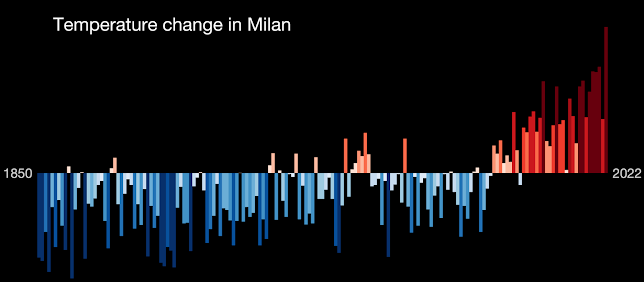WEATHER DATA
Observed Temperature Change in Milan from 1850 - 2022 | (2)
Similar to the records of water meadows, the paleoclimatology record provides us with limited information about past environmental conditions (1). Despite this, the available data can still offer valuable insights into the Earth's climate history.
One notable aspect of this record is the observed increase in global temperatures over the past 172 years. Over this relatively short span of time, the average global temperature has risen by 34.2 ºF (1.2 ºC). This significant temperature increase is clearly depicted in the graph above, indicating a notable warming trend in recent years. Such a rapid rise in temperatures can have profound effects on various aspects of our planet, including ecosystems, weather patterns, and human activities.
Additionally, global warming has caused an increase in the occurrence of extended periods of drought. Droughts can have a detrimental impact on agricultural production, posing a threat to food security and exacerbating existing challenges in farming communities. In these types of circumstances, the utilization of water meadows as a sustainable water management strategy becomes even more vital.
Given the observed warming trend and the associated increase in drought occurrence, the use of water meadows becomes increasingly valuable. Water meadows act as reservoirs by capturing and storing water during wet periods and releasing it gradually during dry spells. This strategic water management helps mitigate the effects of drought by acting as a buffer against climate variability and providing a consistent water supply for crops.
1. Climate change Milan. Meteoblue. (n.d.). https://www.meteoblue.com/en/climate-change/milan_italy_3173435
2. Griffiths, G., & Karkera, M. (n.d.). Show your stripes. #ShowYourStripes. https://showyourstripes.info/b/europe/italy/milan

Comments
Post a Comment